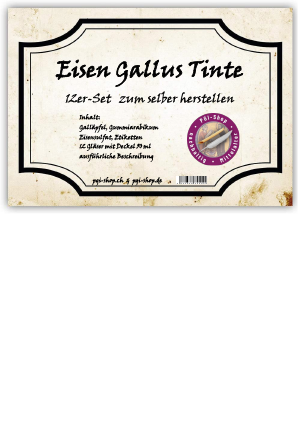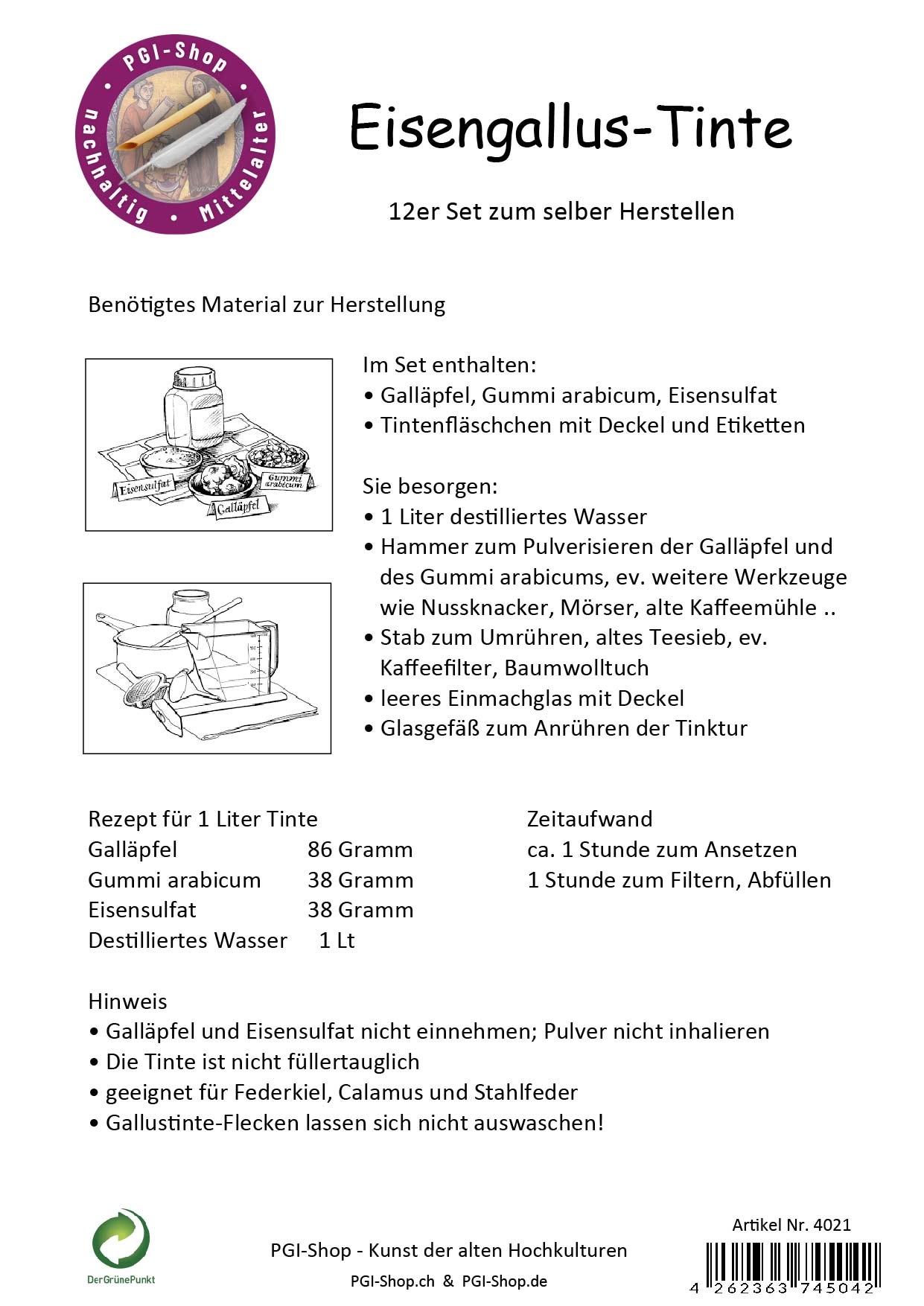Make iron gall ink yourself
Product number:
4021
Set of 12 for making antique iron gall ink.
This set is great for an authentic class or as a special gift.
With little effort, make real ink.
Immerse yourself in the ancient art of writing:
> write personal invitations
> authentic certificates and special letters
> or discover calligraphy
Iron gall ink was widely used from ancient times until the early 20th century. The natural materials give the ink a longevity and the shine of antiquity. Iron gallus ink is particularly well suited for use with a goose quill, calamus or steel nib.
Contents yield approx. 8 dl Ink:
Gallus
Gum arabic
Ferrous sulphate
12 glasses 50 ml
Labels
detailed description
You might still need this:
> 10 quill pens / goose quill - article 4002
> 10 calamus / writing tube - article 4004
> Parchment paper - light - article 4101
> Parchment paper - dark - article 4102
> Papyrus 10 sheets A4 - article 2027
Note: Make ink only under adult supervision. The materials must not be swallowed.
| Aspiration scale: | Medium |
|---|---|
| Time Line: | 2,0 Hours |
Product information "Make iron gall ink yourself"
Historical information
Evidence for the use of iron gall ink, the most important black writing ink of pre-industrial times, has existed since late antiquity. As late as the first half of the 20th century, the use of iron gall ink was obligatory for official documents because it could not be erased. Since the advent of the fountain pen (from about 1900), iron gall ink has been replaced by modern tar dyes for everyday writing.
Iron gall ink is the only historical ink that becomes more or less waterproof. Iron gall inks should not be confused with inks made from black pigments such as soot, binders, etc. Such inks were used in China, India and the United States. Such inks were used for writing in China, India, Egypt and Europe much earlier than iron gall inks.
Gall apples (oak galls)
Galls are caused on various plants (oaks, beeches, spruces, roses, etc.) by, among other things, the sting and egg-laying of various insect species. Only oak galls are used for iron gall ink. Fertilised females of the oak gall wasp lay their eggs on the underside of young oak leaves in May. In the course of the summer, the tree forms the spherical galls to isolate the foreign body. Gall apples are therefore nothing more than a defensive reaction of the plant against a parasite. In the case of the oak, these gall apples contain large quantities of gallic acid, which occurs nowhere else in nature in such a concentrated and easily obtainable form.
Gallic acid has the property of reacting with certain metal salts to form black, bluish, brown or greenish substances. With iron sulphate and oxygen, gallic acid forms an extraordinarily durable black, later black-brown precipitate. The egg of the gall wasp is in no way impaired in its development by the "chemical warfare agents" of the tree. When the larva is fully developed, it leaves the spherical shell through a hatching hole. Galls are harvested only after hatching, in late autumn.
Gall apples as a commercial product, whole or powdered, are usually the grey so-called Aleppo gall apples, which come from Turkey.
Gum arabic
Gum arabic is a secretion of various acacia species, which are mainly found in Senegal and Sudan. Gum arabic is particularly strong in glue and weak in colour and is therefore the most important binder for water-based paints and water-thinnable inks and inks. The commercial forms of gum arabic are powder, pearl barley or the whole, up to 3 cm in size.
In iron gall ink, gum arabic performs the following functions:
1. gum arabic emulsifies tannic acid and ferrous sulphate solution, thereby improving their reactivity. It binds crystallised parts of the ink.
2. increases the surface tension. As a result, the ink runs out less when writing.
3. the gum increases the gloss of the ink, making it appear darker.
4. the binder reduces the corrosive effect and thus forms a protective film.
Ferrous sulphate / ferrous II sulphate
Old names: Iron vitriol, Roman vitriol.
Ferrous sulphate occurs as a natural mineral salt in mines. It is a water-soluble iron-sulphur compound that can be blue, blue-green, light green, grey or ochre in colour, depending on its purity, condition and moisture content. Its form is dry-crystalline to hygroscopic-smeary. It can be produced artificially by dissolving iron in sulphuric acid. Although it is a common mordant for natural dyes and a component of some medicines, ferrous sulphate is not intended for consumption! In ferrous gall ink, ferrous sulphate is the colouring component. The plant only provides the acid necessary for its development.
The water
Use water with as little lime as possible, e.g. demineralised or distilled water, rainwater, melted snow, water that has collected in tree hollows or on stones.
The ageing of iron gall ink
Iron gall ink changes over time, both in the glass and in the dried writing: In the glass, the fresh ink is usually grey-blue; only after writing does it oxidise to black, which happens immediately on alkaline-reacting writing materials, and takes several hours or days on others. Freshly processed iron gall ink strongly stains the fibres of the writing material and becomes insoluble in water after a few days. Further oxidation is not complete even after months or years. This is the reason why iron gall ink turns brown over time (some of the iron it contains turns into iron hydroxide or a kind of rust).
Evidence for the use of iron gall ink, the most important black writing ink of pre-industrial times, has existed since late antiquity. As late as the first half of the 20th century, the use of iron gall ink was obligatory for official documents because it could not be erased. Since the advent of the fountain pen (from about 1900), iron gall ink has been replaced by modern tar dyes for everyday writing.
Iron gall ink is the only historical ink that becomes more or less waterproof. Iron gall inks should not be confused with inks made from black pigments such as soot, binders, etc. Such inks were used in China, India and the United States. Such inks were used for writing in China, India, Egypt and Europe much earlier than iron gall inks.
Gall apples (oak galls)
Galls are caused on various plants (oaks, beeches, spruces, roses, etc.) by, among other things, the sting and egg-laying of various insect species. Only oak galls are used for iron gall ink. Fertilised females of the oak gall wasp lay their eggs on the underside of young oak leaves in May. In the course of the summer, the tree forms the spherical galls to isolate the foreign body. Gall apples are therefore nothing more than a defensive reaction of the plant against a parasite. In the case of the oak, these gall apples contain large quantities of gallic acid, which occurs nowhere else in nature in such a concentrated and easily obtainable form.
Gallic acid has the property of reacting with certain metal salts to form black, bluish, brown or greenish substances. With iron sulphate and oxygen, gallic acid forms an extraordinarily durable black, later black-brown precipitate. The egg of the gall wasp is in no way impaired in its development by the "chemical warfare agents" of the tree. When the larva is fully developed, it leaves the spherical shell through a hatching hole. Galls are harvested only after hatching, in late autumn.
Gall apples as a commercial product, whole or powdered, are usually the grey so-called Aleppo gall apples, which come from Turkey.
Gum arabic
Gum arabic is a secretion of various acacia species, which are mainly found in Senegal and Sudan. Gum arabic is particularly strong in glue and weak in colour and is therefore the most important binder for water-based paints and water-thinnable inks and inks. The commercial forms of gum arabic are powder, pearl barley or the whole, up to 3 cm in size.
In iron gall ink, gum arabic performs the following functions:
1. gum arabic emulsifies tannic acid and ferrous sulphate solution, thereby improving their reactivity. It binds crystallised parts of the ink.
2. increases the surface tension. As a result, the ink runs out less when writing.
3. the gum increases the gloss of the ink, making it appear darker.
4. the binder reduces the corrosive effect and thus forms a protective film.
Ferrous sulphate / ferrous II sulphate
Old names: Iron vitriol, Roman vitriol.
Ferrous sulphate occurs as a natural mineral salt in mines. It is a water-soluble iron-sulphur compound that can be blue, blue-green, light green, grey or ochre in colour, depending on its purity, condition and moisture content. Its form is dry-crystalline to hygroscopic-smeary. It can be produced artificially by dissolving iron in sulphuric acid. Although it is a common mordant for natural dyes and a component of some medicines, ferrous sulphate is not intended for consumption! In ferrous gall ink, ferrous sulphate is the colouring component. The plant only provides the acid necessary for its development.
The water
Use water with as little lime as possible, e.g. demineralised or distilled water, rainwater, melted snow, water that has collected in tree hollows or on stones.
The ageing of iron gall ink
Iron gall ink changes over time, both in the glass and in the dried writing: In the glass, the fresh ink is usually grey-blue; only after writing does it oxidise to black, which happens immediately on alkaline-reacting writing materials, and takes several hours or days on others. Freshly processed iron gall ink strongly stains the fibres of the writing material and becomes insoluble in water after a few days. Further oxidation is not complete even after months or years. This is the reason why iron gall ink turns brown over time (some of the iron it contains turns into iron hydroxide or a kind of rust).




